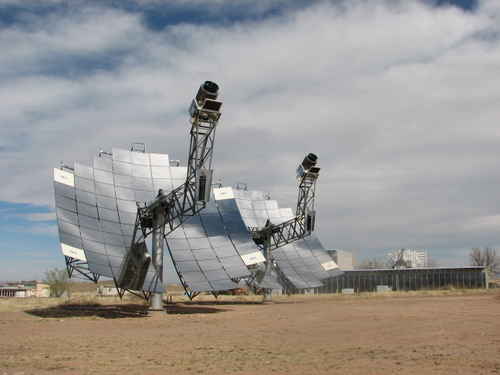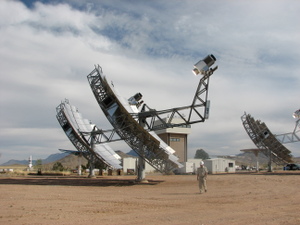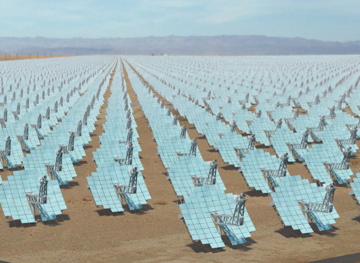Stirling Energy Systems on track to build 1.75 Gigawatts power plant.
This is yet another type of proven Solar Power, from concept to pilot plant and now scaled for statewide supply of electric power. The other proven solar power plants are solar PV, Solar Thermal Molten Salt, and other variations. Solar Stirling Energy Systems developed solar concentrating dishes equiped with a Stirling Engine. It is a major improvement of the Stirling engine, long ago invented. The major disadvantage is that their dish have a lot of moving parts, and many analysts feared that Stirling will never work out and that they will be going under. But it is very healthy to prove skeptics wrong. They are now coming back with a Vengeance.
The major advantage of the Stirling energy systems are a) it has the highest solar efficiency amongst the solar concentrator type of technologies, obtaining 31.25% solar efficiencies, and that is 3 times better than thin film solar, b) uses a lot less water compared to Solar Thermal Power plants utilizing Molten Salt and Steam Turbines and c) each dish is independent separate module that when installed can go into production right away. This means that as each dish comes online, more power is delivered, unlike other solar power plants which required completion in one or two years before electric power is generated.
Joe
Here are the details:
http://greenwombat.blogs.fortune.cnn.com/2007/06/04/big-solar-stirling-energy-systems/


And here's the news article
Putting the big in Big Solar
http://greenwombat.blogs.fortune.cnn.com/2008/07/10/putting-the-big-in-big-solar/

Nearly three years ago, two Southern California utilities caused a stir when they announced deals to buy up to 1.75 gigawatts of electricity from massive solar farms to be built by Stirling Energy Systems of Phoenix. The company had developed a Stirling solar dish - a 38-foot-high, 40-foot-wide mirrored structure that looks like a big shiny satellite receiver. The dish focuses the suns rays on a Stirling engine, heating hydrogen gas to drive pistons that generate electricity.
Plans called for as many as 70,000 solar dishes to carpet the desert. For Southern California Edison (EIX) and San Diego Gas & Electric (SRE) - both facing a state mandate to obtain 20 percent of their electricity from renewable sources by 2010 - it was a big gamble. As the years ticked by and Stirling tinkered with its technology, competitors like Ausra, BrightSource Energy and Solel came out of stealth mode and stole the limelight, signing deals with PG&E (PCG) and filing applications with California regulators to build solar power plants. By the time I visited Stirlings test site in New Mexico in March 2007 for a Business 2.0 feature story, industry insiders were telling me - privately, of course - that Stirling would never make it; Stirling dishes were just too complex and too expensive to compete against more traditional solar technologies.
That may or may not end up being true, but Stirling has moved to silence the naysayers by filing a license application with the California Energy Commission for its first solar power plant - the worlds largest - a 30,000-dish, 750-megawatt project to be built 100 miles east of San Diego on 6,100 acres of federal land controlled by the U.S. Bureau of Land Management. (A energy commission licence application - an extremely detailed and expensive document; Stirlings runs 2,600 pages - is considered a sign that a project has the wherewithal to move forward.)
The first phase of the SES Solar Two project will consist of 12,000 SunCatcher dishes generating 300 megawatts for San Diego Gas & Electric. While the Stirling solar dish is more complex and contains more moving parts than other solar thermal technologies - which use mirrors to heat liquids to generate steam to drive a standard electricity-generating turbine - or photovoltaic panels like those found on rooftops, it also offers some distinct advantages. For one thing, its the most efficient solar thermal technology, converting sunlight into electricity at a 31.25% rate. Each 25-kilowatt dish is in fact a self-contained mini-power plant that can start generating electricity - and cash - as soon as it is installed. Stirling will build 1.5-megawatt clusters of 60 dishes that will begin paying for themselves as each pod goes online. A conventional solar thermal power plant, of course, must be completely built out - which can take a year or two depending on size - before generating electricity.
The 750-megawatt Stirling project will also use relatively little water - no small matter in the desert - compared to other solar thermal plants. According to Stirling, SES Solar Two will consume 33 acre-feet of water - to wash the dishs mirrors - which is equivalent to the annual water use of 33 Southern California households. In contrast, a solar power plant to be built by BrightSource Energy that is nearly half the size is projected to use 100 acre-feet of water annually while a 177-megawatt Ausra plant would use 22 acre-feet, according to the companies license applications.
Still, theres some big hurdles for Stirling to overcome. While it did score a whopping $100 million in funding in April from Irish renewable energy company NTR, the company will need billions in project financing to build Solar Two. And the projects second 450-megawatt phase is dependent on the utility completing a controversial new transmission line through the desert called the Sunrise Powerlink. Depending on how fast the project is approved, construction is expected to begin in 2009 and last more than three years.
The other big unknown is what environmental opposition may develop. Within 10 miles of the SES Solar Two site are proposals to build solar power plants on an additional 51,457 acres of BLM land. Then there are the wildlife issues. Several California-listed species of special concern have been found on the Stirling site, including the burrowing owl, flat-tailed horned lizard and the California horned lark.
Regardless its a big step forward for Stirling. As California Governor Arnold Schwarzenegger said in a statement, This groundbreaking solar energy project is a perfect example of the clean renewable energy California can and will generate to meet our long-term energy and climate change goals.






